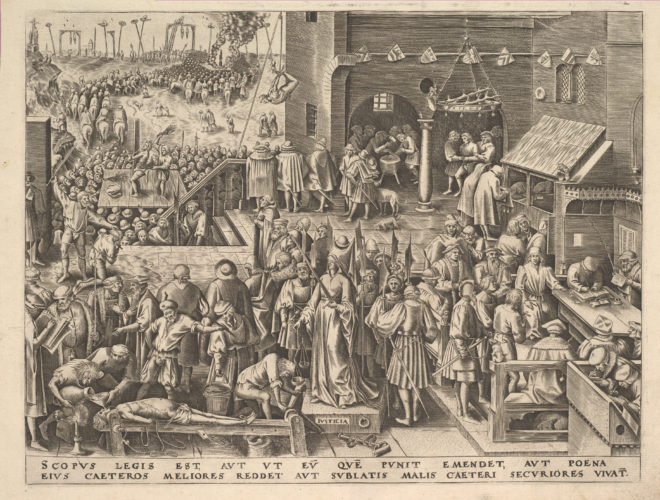This engraving based on a sketch by Pieter Breughel is an allegory of Justice, part of a series on ‘The Seven Virtues’ (1559-60). The canvas is crowded, filled with judges and legal officials (right), and scenes of torture and punishment – notice the man being flogged on a stage surrounded by gaping spectators (left, middle-ground), and another man being racked (left, foreground). A man reads a massive book, perhaps a legal code, on the far left, while formally-dressed and often armed officials appear throughout. But then we see Justitia (or ‘Justicia’), blindfolded, with a sword in one hand and scales in the other, standing front and centre. Ostensibly, this is a representation of the virtue of justice, being dispensed impartially and with authority. But if so, then it figures criminal justice in its institutionalised form, rather than as a personification of a virtue. The Latin inscription at the bottom supports the impression that this spectacle of exemplary social justice, grim as it is, is necessary: ‘The aim of law is either to correct him who is punished, or to improve others by his punishment’.
But what is overwhelming about this penal landscape is its severity and the sense of justice as a bureaucratic machine. The vivid social space in which the allegorical figure of Justice is placed allows realistic evocations of blindness and brutality to play against the positive symbolic meanings of sword and blindfold. The shadow of punishment all but overwhelms the symbolism of Justice, as we see the letter of the law swamping the spirit of equity. The pedestal Justice stands on could also be seen as a pillory or block with a ring attached for shackles. Is Justice purely an admonitory figure, or is she herself on trial, with the cross on the hill in the upper left corner of the image evoking the execution of an innocent man who stood for forgiveness of all mankind’s sins? The image teeters between an exemplary depiction and a critique of a criminal justice system that was Judaeo-Roman in origin, and which was at odds with Christian notions of grace.











